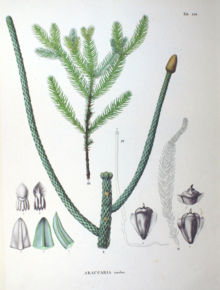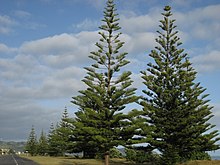Room fir
| Room fir | ||||||||||||
|---|---|---|---|---|---|---|---|---|---|---|---|---|

Norfolk Fir ( Araucaria heterophylla ), Norfolk Island |
||||||||||||
| Systematics | ||||||||||||
|
||||||||||||
| Scientific name | ||||||||||||
| Araucaria heterophylla | ||||||||||||
| ( Salisb. ) Franco |
The Araucaria ( Araucaria heterophylla ), also Norfolk fir called, is a plant from the genus of Araukarien ( Araucaria ) in the family of Araucariaceae (Araucariaceae).
Occurrence
The Norfolk Fir is native to the Norfolk Island at low altitudes . In suitable climate zones (frost-free all year round with very moderate summer temperatures), the Norfolk fir is planted in public green spaces or large gardens.
description
The Norfolk fir grows with a conical shape as an evergreen tree that reaches heights of 50 to 70 meters and trunk diameters of 1.25 to 1.75 meters. As a house plant , the room fir stays smaller. The gray-brown bark falls off in fine scales. On the more or less horizontal or sometimes hanging branches, the branches stand in groups of four to seven in regular whorls . Even the specific epithet heterophylla (for differently leafed) reveals that several leaf types occur in this species. The leaves on young parts of the plant are soft, needle-shaped, 1 to 1.5 centimeters long, curved and pointed. On older parts of the plant, the leaves are scale-shaped, 4 to 5 mm long, curved back, bright dark green and do not overlap. In the areas with cones, the broadly ovate, 6 mm long and 4 to 6 mm wide leaves overlap and have a prickly tip.
Araucauria heterophylla is single sexed ( monoecious ). The several male cones standing together are elongated, about 4 cm long and yellowish-brown to reddish. The pointed microsporophylls have a toothed, ciliate border. The female cones are wider than long with a length of 12 to 18 cm and have triangular scales and long curved bracts. The seeds have a length of 2.5 to 3 cm and a diameter of about 1.2 cm with wide wings. There are four cotyledons ( cotyledons ) are present.
The room fir as a house plant
The indoor fir used to be a popular houseplant in cool, only occasionally heated rooms; The dryness and warmth of continuously (centrally) heated rooms make it difficult to keep the room fir today. It needs a bright, cool location to thrive. In summer it must be bright, but must not be exposed to the blazing sun; the temperature should not exceed 18 degrees Celsius. In winter, the room fir needs a bright room that is between five and ten degrees Celsius cool. In summer it can be kept in a bright, sun-protected place outdoors, in a very bright room directly at the window or in the winter garden, but it does not tolerate midday sun.
Multiplication
The indoor fir can be propagated by head cuttings, but this is difficult. In nurseries, the propagation takes place from seeds or in the laboratory by meristem propagation .
Systematics
This species was first described in 1807 as Eutassa heterophylla by Richard Anthony Salisbury in Transactions of the Linnean Society of London , 8, pp. 316-317. The publication of the species name Araucaria heterophylla took place in 1952 by João Manuel Antonio Paes do Amaral Franco in Anais. Instituto Superior de Agronomia , 19, pp. 11-12. Synonyms for Araucaria heterophylla (Salisb.) Franco are: Araucaria excelsa R.Br. ex Aiton , Dombeya excelsa D.Don , Eutassa heterophylla Salisb.
Araucaria heterophylla belongs to the section Eutacta in the genus Araucaria .
swell
- Christopher J. Earle: Information on Araucaria heterophylla at The Gymnosperm Database , 2010. (Section description and systematics)
- Liguo Fu, Nan Li & Robert R. Mill .: Araucariaceae in the Flora of China , Volume 4, p. 9: Araucaria heterophylla - Online.
Individual evidence
Web links
- Thomas Meyer: Data sheet with identification key and photos at Flora-de: Flora von Deutschland (old name of the website: Flowers in Swabia )
- Araucaria heterophylla in the endangered Red List species the IUCN 2008. Posted by: Conifer Specialist Group, 1998. Retrieved on January 6 of 2009.


